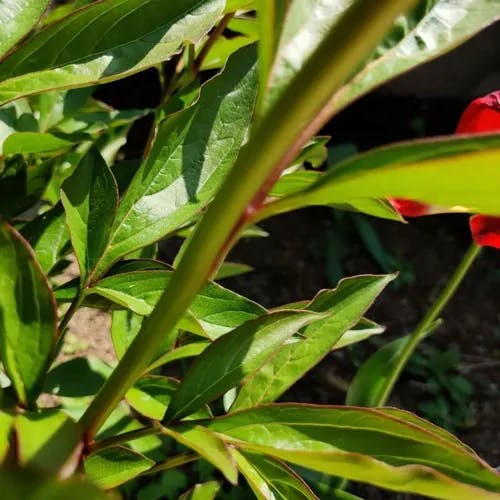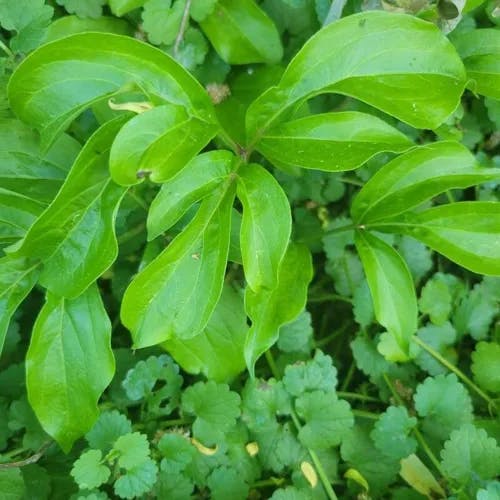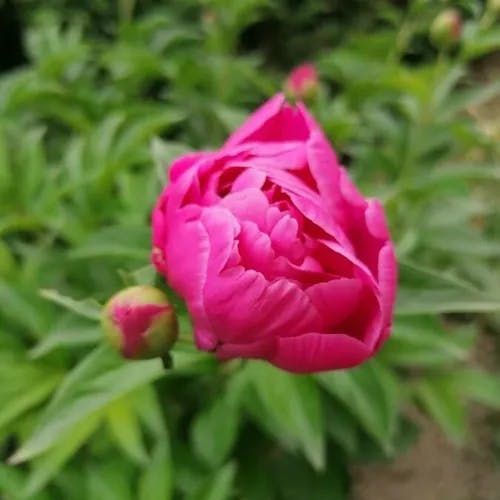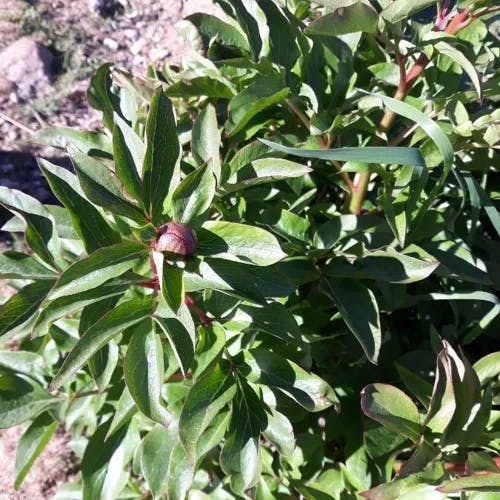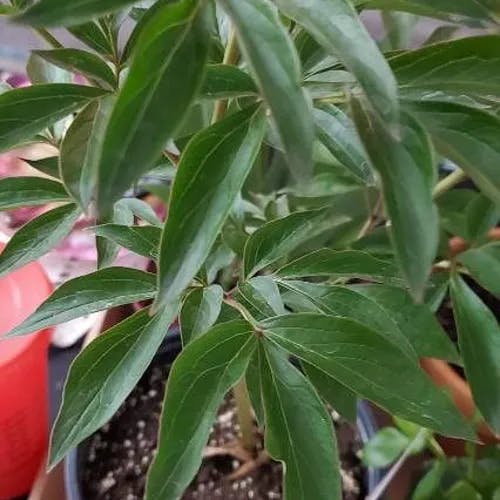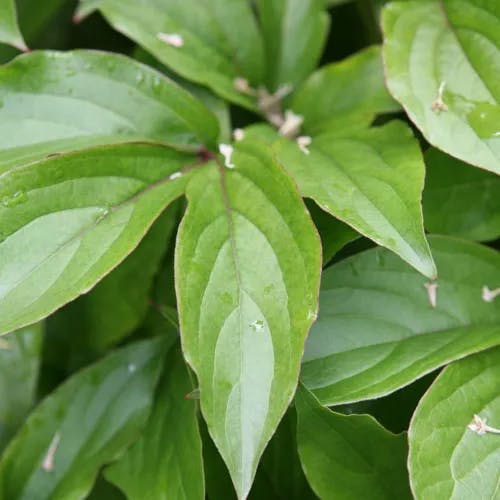Paeonia lactiflora, commonly known as the Chinese peony or common garden peony, is a species of herbaceous perennial flowering plant in the family Paeoniaceae. It is native to central and eastern Asia, specifically China, eastern Tibet, and Mongolia. The plant typically grows to a height of 0.6 to 1.2 meters, with deeply lobed leaves and large, often fragrant flowers. The flowers bloom in late spring to early summer and are available in a range of colors, including white, pink, and red. Each flower has five to ten petals, with a large number of stamens in the center. Paeonia lactiflora is a popular ornamental plant in gardens and for cut flowers, due to its attractive and fragrant blooms. It is also used in traditional Chinese medicine. The plant symbolizes wealth and honor in Chinese culture, and is often used in art and decorations for the Chinese New Year. There are many cultivars of Paeonia lactiflora, with variations in flower color, size, and form. Some of the most popular varieties include 'Sarah Bernhardt', 'Karl Rosenfield', and 'Duchesse de Nemours'. The fruit of Paeonia lactiflora is a dry, splitting capsule containing several large black seeds. The plant is relatively easy to grow, preferring well-drained soil and full sun to partial shade. It is hardy to USDA zones 3-8. In terms of care, Paeonia lactiflora requires minimal maintenance once established, but may need support if the flowers are particularly large. It is also resistant to deer and rabbits, making it a good choice for gardens where these animals are common.
Chinese Peony
- Common name
- Common garden peony,Common Garden Peony
- Scientific name
- Paeonia lactiflora
Basic Information
- Paeoniaceae Family Paeonia Genus Chinese Peony Species
- Paeoniaceae > Paeonia > Paeonia lactiflora
- 83%
- The Completeness of This Encyclopedia
Please help us complete the encyclopedia, Terrarium is a encyclopedia service to be completed with everyone in the world. Currently, this page is 83% complete. For more information on how to contribute, please click here.
- Flower
- Forb/herb
- Perennial
- Height
- 60cm ~ 100cm
- Flower Color
- Leaf Color
- Anthesis
- spring
- Sunlight Exposure
Full Sun Long hours of sunlight from morning to afternoon Partial Shade A location in the shade of a tree or where either the morning or afternoon is shaded Full Shade A place where there is no direct sunlight
- Full Sun
- Hardiness Zones
This is an indicator to know to which zone each plant can winter. Knowing the zone of each plant gives you an idea of the cold temperature resistance when grown in the ground without a roof. 2: -42.7 to -40.0 3: -39.9 to -34.4 4: -34.3 to -28.9 5: -28.8 to -23.3 6: -23.2 to -17.8 7: -17.7 to -12.2 8: -12.1 to -6.7 9: -6.6 to -1.1 10: -1.0 to 4.4 11: 4.5 to 10.0
- 5-8
- Cold resistance
- Excellent
- Heat resistance
- Fair
- Habitat of origin
- China
- Growth Rate
- Normal
What is Chinese Peony (Paeonia lactiflora)?
What is Chinese Peony (Paeonia lactiflora)
Flower meaning
Paeonia lactiflora, commonly known as the Common garden peony, carries several meanings in the language of flowers. In English-speaking countries, it is often associated with bashfulness, shame, or sometimes indignation. For instance, the bashfulness symbol is derived from Greek mythology, where Paeon, a student of Asclepius, god of medicine and healing, was turned into a peony flower because he was bashful when he received more praise than his teacher. In addition, the Common garden peony is the birth flower for people born on June 13th. This flower is also used to represent the 12th wedding anniversary. Please note that the language of flowers can vary greatly depending on the culture and context.
Calendar of Chinese Peony (Paeonia lactiflora)
Calendar
Paeonia lactiflora, also known as the Common garden peony, typically blooms in late spring to early summer in the United States. The peak blooming period usually falls between May and June, depending on the local climate and weather conditions. The blooming process takes about 7-10 days from bud formation to full bloom. To extend the blooming period, it is recommended to plant varieties that bloom at different times and to provide optimal growing conditions. Regular watering, well-drained soil, and full sun to partial shade are essential for healthy growth and prolonged blooming. Deadheading, or removing spent flowers, can also help the plant to focus its energy on producing new blooms. Please note that Paeonia lactiflora is a perennial plant, and it may take a few years after planting before it starts to bloom regularly.
How to grow Chinese Peony (Paeonia lactiflora)
Watering
Paeonia lactiflora, also known as the Common garden peony, requires careful watering to thrive. During the growing season, from spring to early summer, water the plant once a week. Ensure the soil is thoroughly soaked, but avoid waterlogging as this can lead to root rot. In the heat of summer, increase watering to twice a week, especially if rainfall is less than 1 inch per week. Monitor soil moisture levels regularly; the soil should be moist but not soggy. In autumn and winter, reduce watering to once every two weeks or less, depending on rainfall. The plant is dormant during these seasons and excessive water can cause root damage. Remember, overwatering is more harmful than underwatering for Paeonia lactiflora. Adjust watering frequency and amount based on local weather conditions and soil type. Well-drained, fertile soil is ideal for this plant. Always water early in the day to allow excess water to evaporate before nightfall.
Soil and Fertilizer
Paeonia lactiflora, also known as the common garden peony, thrives in well-drained, fertile soil with a pH range of 6.5 to 7.5. The soil should be rich in organic matter, and it's beneficial to incorporate compost or well-rotted manure into the planting hole. Fertilizer application should be done in early spring, using a balanced granular fertilizer with a ratio of 10-10-10 or 14-14-14. Apply approximately 2 cups of fertilizer per plant, sprinkling it around the base and avoiding direct contact with the stems. Fertilizer application should be repeated after the blooming period, but not later than the end of July. Over-fertilization can lead to lush foliage at the expense of blooms, so it's important to follow the recommended rates. Maintaining soil quality is crucial for the health of Paeonia lactiflora, and it's recommended to conduct a soil test every 2-3 years to monitor nutrient levels and pH.
Sunlight and Place
Paeonia lactiflora, also known as the Common garden peony, thrives in full sun exposure but can tolerate partial shade. It requires at least six hours of sunlight per day for optimal growth and flower production. The plant is cold-hardy and can withstand winter temperatures as low as -20 degrees Fahrenheit. However, it is not heat-tolerant and prefers cooler summer temperatures, ideally below 80 degrees Fahrenheit. During hot summers, it is advisable to provide some afternoon shade to prevent leaf scorch. The plant should be placed in a location where it can receive morning sunlight, which is less intense and beneficial for its growth. Despite its preference for cooler temperatures, Paeonia lactiflora is resilient and can adapt to a range of conditions, provided it receives adequate sunlight. In terms of placement, it is important to ensure that the plant is not overshadowed by taller plants or structures that could limit its sun exposure.
Advanced Information of Chinese Peony (Paeonia lactiflora)
Pruning
Paeonia lactiflora, commonly known as the garden peony, requires minimal pruning. Pruning is necessary to remove spent flowers and to maintain the plant's shape. The best time to prune Paeonia lactiflora is in the fall, after the plant has finished blooming and the foliage has died back. To prune, cut back the stems to ground level, taking care not to damage the crown. After pruning, remove all plant debris from the area to prevent the spread of disease. In the spring, new growth will emerge from the crown. Regular pruning helps to ensure a healthy, vigorous plant. Remember, over-pruning can stress the plant and reduce flowering, so it's best to prune sparingly. Always use clean, sharp tools when pruning to prevent the spread of disease. Proper pruning of Paeonia lactiflora will enhance its beauty and longevity.
Planting and Harvest
Paeonia lactiflora, also known as the common garden peony, is a perennial plant that can be grown in pots or in-ground. For potting, choose a large, deep pot with good drainage. Fill the pot with a well-draining soil mix, plant the peony so that the eyes (buds) are 1-2 inches below the soil surface. Water thoroughly after planting, and place the pot in a location with full sun to partial shade. For repotting, do it in the fall, carefully removing the plant from the pot and dividing the root ball if it has become too large. Replant the divisions in fresh soil, again ensuring the eyes are 1-2 inches below the soil surface. While Paeonia lactiflora can be grown in pots, it tends to thrive better in-ground due to its deep root system. For best results, provide regular watering, but avoid waterlogging the soil.
Propagation
Paeonia lactiflora, also known as the common garden peony, is best propagated through division. This method is preferred as it ensures the new plants retain the characteristics of the parent plant. To propagate by division, dig up the plant in early autumn, carefully keeping the root ball intact. Divide the root ball into sections, each with at least three eyes (buds). Replant these divisions immediately at a depth of 2 inches, ensuring the eyes face upwards. Water thoroughly after planting. Seed propagation is also possible but less reliable, as it may not produce plants identical to the parent. To propagate by seed, collect ripe seeds in late summer and sow them in a cold frame. Germination can take up to two years. Remember, Paeonia lactiflora prefers full sun to partial shade and well-drained soil. Ensure these conditions are met for successful propagation.
Pests and Diseases
Paeonia lactiflora, also known as the common garden peony, is susceptible to a variety of pests and diseases. One of the most common pests is the peony borer, a type of caterpillar that feeds on the plant's stems and leaves. This can lead to wilting and death of the plant if not treated promptly. To prevent infestation, regular inspection of the plant for signs of the borer, such as holes in the stems and leaves, is recommended. Botrytis blight, also known as gray mold, is a common disease that affects Paeonia lactiflora. This fungal disease causes the plant's buds and stems to turn brown and rot. To prevent this disease, it is important to maintain good air circulation around the plant and avoid overhead watering, which can create a damp environment that encourages fungal growth. Another disease that can affect Paeonia lactiflora is leaf blotch, caused by the fungus Cladosporium paeoniae. This disease causes red or purple spots to appear on the leaves, which can eventually lead to leaf drop. To prevent leaf blotch, it is recommended to remove and dispose of infected leaves and to avoid wetting the leaves when watering. Paeonia lactiflora can also be affected by root rot, a condition caused by overwatering or poor drainage. This can lead to wilting and death of the plant. To prevent root rot, it is important to ensure that the plant is planted in well-draining soil and not overwatered. In conclusion, regular inspection and proper care can help prevent most pests and diseases that affect Paeonia lactiflora.
Habitat of Chinese Peony (Paeonia lactiflora)
Habitat
Toxicity of Chinese Peony (Paeonia lactiflora)
Health Benefits
- edible
- Inedible
- Toxic
- No toxicity
NO DATA
Toxic for dogs and cats
NO DATA
Q&A of Chinese Peony (Paeonia lactiflora)
- What are the best peony varieties for Zone 9?
The most suitable peony cultivars for Zone 9, characterized by its warmer climate, encompass the 'Festiva Maxima,' 'Sarah Bernhardt,' and 'Karl Rosenfield.' These selections, all belonging to the Paeonia lactiflora species, commonly referred to as the common garden peony, are celebrated for their tenacity and capacity to acclimate to the demands of a milder climate. The 'Festiva Maxima' boasts timeless appeal with its generously sized, sweetly scented white blossoms. Meanwhile, the 'Sarah Bernhardt' garners popularity on account of its abundant, double-petaled pink flowers and robust fragrance. Not to be outdone, the 'Karl Rosenfield' commands attention with its richly hued, double red blooms. These cultivars not only exhibit resilience to high temperatures but also grace gardens with their captivating, fragrant flowers. Nonetheless, it is imperative to acknowledge that even these varieties necessitate a measure of winter cold for successful flowering, potentially impacting their performance in tropical climates.
0
0
- How are garden peonies classified?
Garden peonies, scientifically known as Paeonia lactiflora, belong to the Paeoniaceae family, a constituent of the Saxifragales order encompassing a diverse array of flowering plants. Peonies are further categorized into three primary classifications: herbaceous peonies, tree peonies, and intersectional peonies. Herbaceous peonies, renowned for their sizable and aromatic blossoms, rank as the most prevalent. Tree peonies, distinguished by their larger size and woody stems, offer an alternative facet. Intersectional peonies, a hybrid offspring of the former two, form another intriguing category. Within each peony classification, an assortment of cultivars flourishes, unveiling distinctions in flower hue, configuration, and dimensions. These categorizations serve as valuable tools for botanists and horticultural enthusiasts alike, facilitating the identification and selection of peonies tailored to particular objectives or aesthetic inclinations.
0
0
- Is there a recommended way to choose Paeonia lactiflora?
Paeonia lactiflora, also known as the Common garden peony, is a perennial plant renowned for its diverse array of colors and forms. When in the market for seeds or seedlings, it's essential to deliberate on the variety. 'Sarah Bernhardt' stands out as a favored choice, boasting sizable, double pink blossoms. Meanwhile, the 'Karl Rosenfield' variety showcases double red flowers, celebrated for its robust stems. If you're inclined towards white blooms, 'Festiva Maxima' offers large, fragrant flowers. When opting for seedlings, prioritize the acquisition of robust, disease-resistant plants characterized by a sturdy root system. In the case of seeds, ensure they exhibit plumpness and remain free from any manifestations of mold or harm. It's paramount to bear in mind that Paeonia lactiflora thrives in sun-drenched locations boasting well-drained soil. When selecting varieties, make a point to align them with your regional climate zone, as hardiness may vary. Lastly, it's prudent to acknowledge that Paeonia lactiflora may take a few years to become well-established and commence its flowering journey, necessitating a degree of patience.
0
0
- Where to find garden peonies?
Garden peonies, scientifically known as Paeonia lactiflora, are commonly encountered in temperate regions and are highly favored in both residential landscapes and public green spaces. They thrive within the USDA hardiness zones spanning from 3 to 8, encompassing regions across North America, Europe, and Asia. These botanical specimens exhibit a marked preference for well-draining soil and an exposure range from full sun to partial shade. Typically, they are introduced to the soil during the autumn season, typically about a month before the ground undergoes freezing temperatures. It's worth emphasizing that peonies are enduring perennial plants capable of enduring the same location for as long as 50 years, provided they receive the requisite care and attention. Beyond private gardens, garden peonies are readily available in local nurseries and garden centers, especially during the prime planting season. Furthermore, a diverse array of peony plants and seeds is accessible through online retailers and seed catalogs.
0
0
- What are the dark shades of peony flowers?
The rich, velvety tones of the common garden peony, scientifically known as Paeonia lactiflora, encompass a captivating spectrum of deep burgundy, maroon, and nearly ebony hues. These profound and opulent shades often form a striking juxtaposition with lighter, contrasting tones nestled at the heart of the blossoms. It is paramount to acknowledge that the coloration of peony blooms is subject to significant variation contingent on the specific cultivar and the prevailing growth circumstances. Under cooler climatic conditions or diminished exposure to sunlight, certain varieties may manifest darker and more intense hues. To cultivate peonies with an inclination toward darker shades, it is prudent to opt for varieties renowned for their profound coloration and to provide them with the conducive growth conditions they require.
- How to obtain tree peonies?
Obtaining tree peonies, scientifically classified as Paeonia suffruticosa, can be accomplished through various avenues. The most prevalent approach involves procuring them from well-regarded nurseries or reputable garden centers. These establishments typically offer an assortment of cultivars, affording you the opportunity to select based on your personal preferences regarding flower color, form, and plant dimensions. Alternatively, propagation from seeds or grafting constitutes another means of acquisition. Nonetheless, it's crucial to recognize that these methods necessitate a certain level of horticultural expertise and entail a span of several years before the plant attains maturity and commences blooming. Additionally, it is worth highlighting that tree peonies thrive in sun-drenched locations boasting well-drained soil with a pH level that ranges from neutral to slightly alkaline. While they are robust by nature, they do benefit from some shielding against inclement winds. Lastly, it is prudent to ascertain the legal regulations governing plant acquisition in your region, as certain species or cultivars may be subject to protection or restrictions.
0
0
